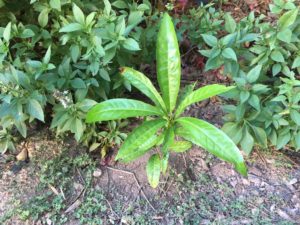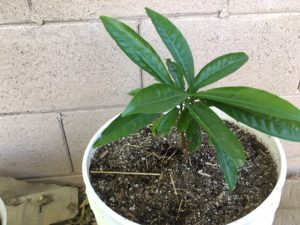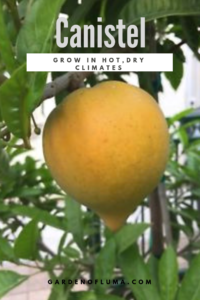Growing Canistel in Hot, Dry Climates

I’ve searched high and low for a Canistel (aka Yellow Sapote or Eggfruit) to try in the Phoenix, Arizona area. I’ve been able to find a lot of unique tropical fruits to try at various ethnic markets, but Canistel hasn’t been one of them. Since it’s another one of those trees that are marginal for my area and I’ve never been able to try the fruit, I’ve decided to try my luck with growing this tree from seed.
Growing Canistel from Seed
The Canistel seeds are quite large and look similar to a Macadamia Nut.
They have a really hard shell on the seed which if left on, will cause germination to take a lot longer.
You can use pliers or a nutcracker to carefully crack the outer shell and peel it off.
The seeds need to be fresh to germinate, so it’s important to order them from a reputable seller.
After you get the shell off, the seed is ready to sow.
I attempted to germinate my seeds in a few different ways.
I had success with planting directly in the ground and starting the seed in a soil-less mix indoors.
It seems as if the seeds are fresh than the germination rate is fairly high.
It took around 3-4 weeks for germination to occur.
Philippine Pointed Canistel

Fruitlovers.com is a great place to find rare and exotic tropical fruit tree seeds.
The seeds that I purchased from Fruitlovers.com were labeled as Phillippine Pointed Canistel.
From the few things I’ve been able to find on this variety, everything has stated that the fruit is one of the better tasting Canistel varieties.
The tree has been a fairly slow grower, which tends to happen in our hot, dry climate.
I’m hoping that growing from seed will help it to be a bit more vigorous than a grafted tree.
Grafted Canistel can produce proven varieties, but growing Canistel from seed is also a common method of propagation.
The tree has beautiful foliage. The leaves are a glossy green and flush in clusters.
Fruit
The fruit can be a somewhat large fruit, similar to the size of a grapefruit.
Some are more rounded in shape and others are more pointed.
Canistel is reported to have the texture similar to that of an egg yolk.
Some varieties are moister, while others have a drier texture.
The Phillippine Pointed variety is reportedly a variety that is a moist flesh which makes it taste much better.
I’m a huge fan of the Pouteria fruit varieties that I’ve been able to try which include Mamey Sapote and Sapodilla.
Some people say it has a similar taste to a baked sweet potato or pumpkin pie.
I love a good glass of eggnog around the holiday’s and supposedly Canistel tastes like Eggnog in a milkshake.
Gardening Skill Level
I would rate growing a Canistel Tree for the advanced gardener that wants more of a challenge in hot, dry climates.
Canistel comes from a more humid tropical region which makes it tougher to grow without humidity.
It’s going to need cold protection with temps below freezing and can easily be killed by temps below.
Mature trees are supposed to be able to handle a little bit more cold than many of the tropical fruit trees.
I’ve seen that it can take down to around 26 degrees Fahrenheit.
Suitable for Container Growing

I’m attempting to grow one of my Canistel Trees in a container.
I want to keep one in a container to be able to bring it inside during any cold snaps.
My theory is that if it is more of a slow grower in our climate than it should do well in a container.
Canistel Trees can be kept fairly small anyway.
They are naturally smaller trees. I recommend a soil mix that provides adequate drainage, like a cactus mix, but still retains enough moisture.
Planting Tips
Canistel needs a good microclimate for our environment.
It should be planted in a more sheltered spot so it can have some shade.
It’s a good tree to plant in between other trees or under a canopy of a large tree to help protect it in the winter.
Watering
This is a tropical fruit tree, so it requires more water during the hot, dry months.
I water my container tree daily during the hottest parts of the year.
I also have a seedling in the ground, which doesn’t get daily water, but still a few times per week in the hottest parts of the year.
Feeding
I’ve been feeding my Canistel trees with liquid fish fertilizer and liquid seaweed.
Occasionally, I’ll apply some compost throughout the year.
I back off on the synthetic granular’ s for most of my tropical fruit trees, due to the salt sensitivity and tendencies to salt burn in our higher PH soil.
Here are my product recommendations.
Sun Exposure
Canistel likes sun, but not too much of our extreme desert sun.
I wouldn’t plant this tree in full all day sun in our climate.
I have my trees in mostly shade, just getting early morning sun.
As they get older, I may try to give them a bit more sun.
Potential Problems
I haven’t noticed any major problems with bugs with my Canistel Trees or any diseases in the early stages of this tree.
The Canistel trees seem to do fairly well dealing with our higher PH challenges and I don’t see too much of an issue with salt burn.
I’ve read that Canistel can have issues with excess salts, so that will be something I’ll be monitoring.
Iron deficiencies can be common with tropical fruit trees in high PH soil, but I haven’t noticed any problems in my young trees.
The leaves have held up with our dry hot winds and don’t seem to get thrashed like some other tropical in our dry heat.
The main potential problem that I foresee is keeping it warm enough through the winter.
Please comment below on anything you enjoyed from this post or your experience with growing Canistel trees in hot, dry climates.


How is your canistel doing? How many years do you expect before getting fruit? Do you have mame sapote gdrowing also? Which seed supplier did you get seeds from? I live in Tucson and would like to try some fruit in this family.
I have 4 Canistel seedlings that I started summer of 2018. 3 of them are in the ground and 1 in a container. I didn’t frost protect any of the ones in ground and as you know, we had a cold winter. Two of them are struggling, but still alive. The one in the container and the other in the ground are doing well, starting to grow as we warm up. I don’t have Mamey Sapote. I purchased my canistel seeds from fruitlovers.com What are you growing down there in Tucson?
I live near University and Country Club in Mesa. I just got a box of Canistel fruit delivered that isn’t ripe yet. My new Trompo Canistel was delivered yesterday to go with my seedling canistel that is doing well since being planted in 2004 without blossoms yet. A branch was broken so my seedling has already been grafted with the Trompo. Perhaps I could come for visit and bring some canistel fruit when it ripens up in a week or so. I just found your site since I ordered the Trompo which came in the same box as my new makok sapodilla. If I come before planting my Trompo maybe I could bring it over and graft a piece onto your seedling. Happy growing Monty
Shoot I didn’t see this until now. I would’ve liked to try the Canistel!
I got a blossom on my canistel last year. It was on the Lucuma graft I put on in March 2021. This is so far the only blossom since I planted the canistel in 2004. A local nursery whose owner has a YouTube channel about exotic fruiting plants says our temperatures are too high for canistel to set fruit. I have recent canistel plants that also blossomed but failed to set fruit. I intend to set a timed mister on the canistel plants during blossoming to see if the high temperature effect can be reduced.